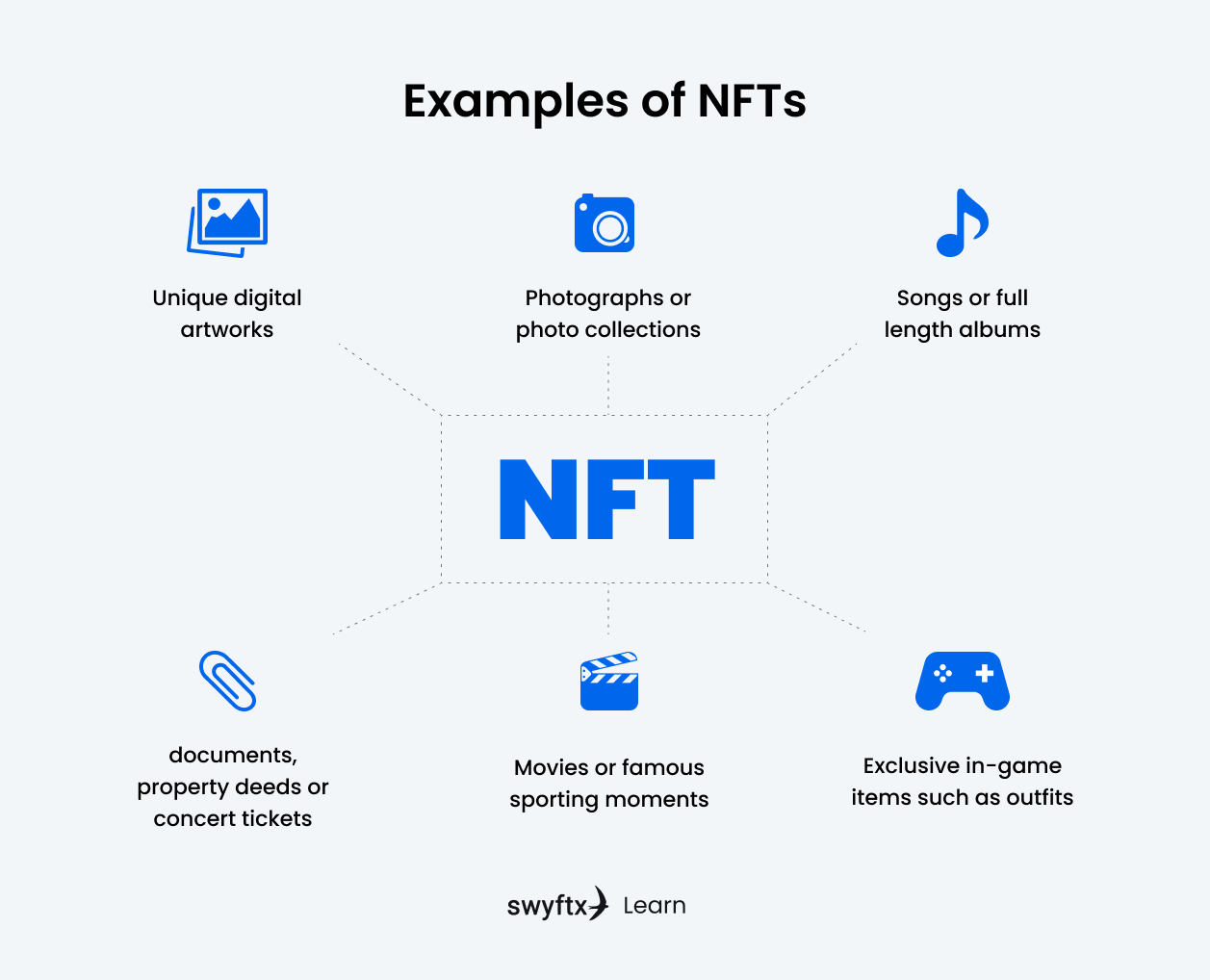
NFTs have only been around for a few years, but they have taken the crypto world by storm. They have proven not to be just a passing fad, but something that has a wide range of utility. This guide will discuss what NFTs are and how they originated. It will also look at the different types of NFTs and what the future might hold for them.
What is an NFT?
Non-fungible tokens (NFTs) are an application of blockchain technology that makes each token totally unique, and therefore verifies its digital scarcity. An NFT represents a unique digital asset and proves ownership using a unique digital signature that cannot be forged.
Fungible is an economic term that describes a good or commodity that is interchangeable with something else, irrespective of its value. For instance, the value of the U.S. dollar fluctuates, but the value of one dollar relative to another dollar remains the same. There is no need to make a distinction between one $20 bill and another $20 bill, because they have the same value, and are therefore interchangeable. The same is true with many cryptocurrencies because they are interchangeable with each other.
Non-fungible is the opposite. It is something that is completely unique and therefore not interchangeable. So far, the most popular use case for NFTs has been digital collectables, such as digital artwork or digital files. But any real-world assets that are classified as non-fungible can be digitally represented by non-fungible tokens and encoded with unique details using a smart contract.

What are the origins of NFTs?
The origin of NFTs can be traced back to Colored Coins, introduced around 2012/13, which were made up of small denominations of a Bitcoin that could be used to represent a variety of assets, such as coupons, subscriptions, or even property. Colored Coins represented an innovative new use of blockchain technology, but had some flaws around reaching consensus, so the project didn’t stand the test of time.
In 2014, Counterparty made it possible for users to create their own unique digital tokens that could represent a range of digital and real-world assets and services. The most notable creations were trading cards and a large collection of tradeable memes. Together, Colored Coins and Counterparty laid the foundations that NFTs were built upon. But it was the emergence of the Ethereum platform and smart contracts that made NFTs truly possible. Crypto Punks and Crypto Kitties, both released in 2017, are the best early examples of NFTs. Both are collections that were not huge on launch, but have since gained cult followings.
Pop Quiz!
What does NFT stand for?
Why do NFTs have value?
NFTs are valuable because they represent something unique—such as a piece of art, music, digital files, or an in-game collectable—and certify ownership digitally. Before NFTs, it was very difficult to authenticate and “own” music or a digital image because of how easy it is to download a file or take a screenshot. But NFTs provide a unique signature that cannot be altered, which makes it a quick and secure way to prove ownership of a unique or scarce asset that others may want.
Say you own Crypto Punk #3389. That means that no one else in the world can claim ownership of that piece of art. The blockchain can verify that it is stored in your personal digital wallet, and therefore owned exclusively by you. Of course, someone could download a jpeg version or take a screenshot, but its value would be purely cosmetic because it would be a low-resolution replication, not the original.
Types of NFTs
There are a bunch of different NFT categories. The majority of them are in the digital space right now, but there are definitely applications of NFT technology in relation to real-world assets too. Most NFT platforms run on the Ethereum network, but other blockchains, such as Solana, have gained a lot of traction in the NFT world as well.
Art
Art is the most popular type of NFT. Digital artists in particular have jumped on the opportunity to sell their artwork through a blockchain platform that improves on the traditional process that was used to sell physical art. It has had a big impact on the art world, because digital artists can receive excellent exposure in the NFT space and potentially make more money than through traditional methods. As an added bonus, transactions are handled quickly and securely through smart contracts, which makes life a lot easier for artists to sell digital art.
Most successful pieces of NFT art are part of a large collection, such as Crypto Punks, which is a set of pixel art portraits, each of which is completely unique. The most expensive one so far is CryptoPunk #7523, which sold for almost $12 million USD.

Figure 2 – 12 Random Crypto Punks
Music
Music is another popular type of NFT. Music has been a fungible product for years, because after it has been recorded it is copied and distributed on records, cassettes, CDs, or as digital copies. However, NFTs allow musicians and DJs to sell unique or limited run pieces of music or albums.
One of the appealing things about NFTs for musicians is that they receive a much larger portion of the revenue. In the traditional music industry, a large cut of proceeds goes to the record label, the publisher, and the artist’s manager. In some instances, this only leaves the artist with 10-15% of the proceeds of their music. But with NFT music, the person creating and listing the NFT receives the majority of the revenue, minus a fee for the NFT platform.
Did You Know?
The signature of all NFTs is completely unique, but the content doesn’t have to be. For instance, a musician could create 1,000 NFT copies of an album. The album content would be identical, but there would only be 1,000 copies in existence, making it a rare, collector’s item. Taking this thought further, a musician could create 10 super rare copies that contained a few extra tracks or a video for example. The possibilities are endless.
Game items
NFTs have been adopted by the gaming industry as well, particularly free to play games. In the existing model, the base game is free, but you can purchase additional items, usually cosmetic items such as outfits, decals, stickers, and emotes. Games that have adopted NFT technology are able to offer gamers rare or unique in-game items that can be traded within the in-game ecosystem.
Projects like Axie Infinity and Decentraland are great examples of games or virtual worlds utilizing NFT technology. Decentraland is an immersive digital world that players can occupy, explore and purchase digital real estate. Players can create, buy, and sell their own unique digital assets (NFTs), such as land, houses, characters, costumes, and avatars.
In Axie Infinity, players can acquire, breed, train, and battle creatures known as Axies. They can also acquire small love potions (SLPs), which can be used to breed new Axies. SLPs double as a cryptocurrency that can be bought and sold on a crypto exchange.
Sports highlights
The sporting industry has definitely taken note of the technology, creating NFTs out of memorable sporting highlights, such as famous slam dunks or pivotal touchdowns. The NBA in particular has invested quite heavily in creating and distributing NFTs from NBA games over the last few decades. Anyone can watch replays on YouTube, but now you can literally own one of Lebron James’ slam dunks.
Memes
Many popular memes are also up for grabs in the NFT market. For the most part, the sellers are the original creators or stars of the meme. For example, the original sellers of the “Disaster Girl” and “Charlie Bit My Finger” memes were the stars of each meme. The world’s most valuable meme so far is the Doge meme, which sold for $4 million USD.

Figure 3 – Disaster Girl meme
The Future of NFTs
Although NFTs are still in their infancy, they have already proven to have a lot of utility, especially in the ever-expanding world of digital collectables. As with all new technologies, there is always a teething period where unforeseen issues arise and have to be solved. This is similar to how the Lightning Network improves on the transaction speed and cost of Bitcoin.
There have already been a number of issues with NFTs. First, the amount of energy required to mint and buy new NFTs. Second, the uncertainty about what happens if the platform that issues and hosts NFT content goes out of business. And third, copyright issues where someone can own the NFT of an image or video, but not copyright ownership to it, thus leading to complex ownership claims.
These issues will need to be solved before NFTs can reach their full potential. But it is likely that we have only seen the tip of the iceberg when it comes to the potential of NFT technology. Things like concert tickets, gym memberships, and vaccine passports could all potentially use NFT technology. The real estate industry could also use NFTs to prove ownership of property, which could be sold quickly and safely to a new buyer, like an ultra-secure Monopoly title deed card.
Key Takeaway
NFT technology is still very new, and as such there are a number of issues that still need ironing out. But NFTs have a huge amount of potential in a variety of exciting areas that will probably be explored in the next few years.
Where to buy NFTs
There are a number of dedicated NFT marketplaces where you can buy NFTs, such as OpenSea and Foundation. You can also buy NFTs directly through a number of different cryptocurrency exchanges, with more exchanges expected to add an NFT marketplace in the future.
Summary
NFTs are an innovative use of blockchain technology to prove ownership of unique digital assets. They have proven not to be just a flash in the pan, as some suspected, but a technology with much potential. This piece has discussed what NFTs are and how they began. It has also looked at the different types of NFTs and what the future might hold in the NFT space. If you’d like to learn more about cryptocurrency or smart contracts, Swyftx Learn has plenty of great material waiting for you.
Next lesson
Disclaimer: The information on Swyftx Learn is for general educational purposes only and should not be taken as investment advice, personal recommendation, or an offer of, or solicitation to, buy or sell any assets. It has been prepared without regard to any particular investment objectives or financial situation and does not purport to cover any legal or regulatory requirements. Customers are encouraged to do their own independent research and seek professional advice. Swyftx makes no representation and assumes no liability as to the accuracy or completeness of the content. Any references to past performance are not, and should not be taken as a reliable indicator of future results. Make sure you understand the risks involved in trading before committing any capital. Never risk more than you are prepared to lose. Consider our Terms of Use and Risk Disclosure Statement for more details.


 Article read
Article read


